Probably? Didn't you make a post about thermohaline circulation causing catastrophic cooling in Europe?Probably, but who cares?
Navigation
Install the app
How to install the app on iOS
Follow along with the video below to see how to install our site as a web app on your home screen.
Note: This feature may not be available in some browsers.
More options
Style variation
You are using an out of date browser. It may not display this or other websites correctly.
You should upgrade or use an alternative browser.
You should upgrade or use an alternative browser.
The Glacial-Interglacial Cycle is Driven by Orbital Forcing
- Thread starter Crick
- Start date
Did you really just say who cares about abrupt climate change?who cares?
Isn't your whole purpose here to argue that abrupt climate change is a problem?
daveman
Diamond Member
Obviously, world socialism is the only thing that can moderate the Earth's orbit!
- Thread starter
- #25
Then you could provide them here without difficulty.For Greenland, all already linked.
The top of what? Northern Greenland? The top of Greenland's ice cap?Top was green 2 million years ago.
Middle? Middle latitudes? Central highlands? Does the middle include the top? Does the top include the middle? Are they two separate areas? And what do you mean by "went forest to ice age"Middle went forest to ice age 440-800k year ago
The Viking settlements in Greenland were limited in area and duration. And just like Iceland, the island was named deceptively. The Viking observations are of little value.Viking history
Ice core data can show a surface melt, but if the ice melts completely and the area becomes vegetated, there is no ice to record anything.Ice core data
I've become convinced that you speak in this "stylish" manner to make it as difficult as possible to tell what you are actually saying. You are not attempting to convey information, but only to give an impression. You wish to provide as few concrete statements as possible in order to minimize your vulnerability to examination.For North American Ice Age, the comparison is McBullshit vs. Greenland and Antarctica today, and everything McBullshit is off by a factor of 10 or more...
Following the links in your linked post, we find articles about DNA found on the bedrock underneath the ice cap. These indicate arboreal conditions across at least the southern third of Greenland 450,000 - 800,000 years ago and arboreal conditions in Peary Land, Northern Greenland, about 2 million years ago. The intervening timeline you've simply filled in with your imagination. You seem to have no data concerning conditions in North American during those periods, yet they are actually well studied and well established. You have simply chosen to reject all those data just as you reject the entire world's collection of contemporary, instrumented temperature data because they do not support your ignorant contentions.
How old were the 2.5 mile thick glaciers covering Chicago in the past 20k-5 million years?
This is where the climate debate is now stuck. Every piece of land within 600 miles of a pole is in ice age, everything outside of that is not. Nobody has attempted to dispute that. It is the clear truth of Earth today. Milankovitch Cycles, which I call McBullshit Cycles, take a very...www.usmessageboard.com
Last edited:
EMH
Diamond Member
- Apr 5, 2021
- 22,301
- 13,525
- 2,288
- Banned
- #26
The top of what? Northern Greenland? The top of Greenland's ice cap?
The link documents that 2 million years ago, northern Greenland was green, meaning all of Greenland, save mountain tops, was green.
And what do you mean by "went forest to ice age"
That expedition drilled through the thickest part of Greenland's ice sheet, near the "center latitude," and pulled out pine cones etc. dated 450k-800k years ago... ie the ice started up north and flowed south, getting near the middle during that time frame.
The Viking settlements in Greenland were limited in area and duration. And just like Iceland, the island was named deceptively. The Viking observations are of little value.
Bullshit. The Vikings farmed the southern tip until the 1400s, and their dwellings are buried under ice now. That is the same ice sheet that originated at the top of northern Greenland and moved south. Greenland's continent specific ice age took 1-2 million years to cover the continent as it does today. That translates to a speed of about a mile every thousand years, which if applied to McBullshit's explanation of North American Ice Age, would mean 75k years after the start of North American Ice Age, the glaciers were not even 1/10th the distance needed to get to Chicago. And since we know there were still big glaciers from North American Ice Age 10-20k years ago, it is indisputable truth that
GREENLAND FROZE WHILE NORTH AMERICA THAWED
blowing the entire Co2 and glacials BULLSHIT UP COMPLETELY.
The melting of the vast continental ice sheets, which began ~20,000 years ago due to gradual changes in the seasonal and spatial distribution of the Sun's energy (Broecker & Von Donk 1970), was interrupted by several abrupt cold climate events. The two largest deglacial events in the North Atlantic — known as Heinrich Stadial 1 and the Younger Dryas — occurred approximately 17,500–14,600 and 13,000–11,500 years ago respectively (Figure 6) (Heinrich 1988, Bond et al. 1992, Grootes et al. 1993).When was the last one, abrupt climate change?

- Thread starter
- #28
Abstract from Broecker & Von Donk 1970The melting of the vast continental ice sheets, which began ~20,000 years ago due to gradual changes in the seasonal and spatial distribution of the Sun's energy (Broecker & Von Donk 1970), was interrupted by several abrupt cold climate events. The two largest deglacial events in the North Atlantic — known as Heinrich Stadial 1 and the Younger Dryas — occurred approximately 17,500–14,600 and 13,000–11,500 years ago respectively (Figure 6) (Heinrich 1988, Bond et al. 1992, Grootes et al. 1993).

A detailed curve of ice volume versus time is needed in order to test the validity of the hypothesis that changes in the earth's orbital parameters are the cause of oscillations in Pleistocene climate. Although absolute ages available for glacial moraines and raised coral reefs provide a number of key points, they by no means allow a continuous curve to be drawn. Those points that exist, however, are entirely consistent with the hypothesis that the O18/O16 curves from deep-sea cores provide good approximations to the ice volume record. If so, then the primary glacial cycle must be sawtoothed in character; gradual glacial buildups over periods averaging 90,000 years in length are terminated by deglaciations completed in less than one tenth this time. Modulating this primary cycle are secondary oscillations. Those recognized during glacial growth phases average 20,000 years in length and those during the retreats about one thousand years in length. When the ice volume curve obtained in this way is compared with the summer insolation curve for the northern hemisphere, it is seen that the rapid deglaciations occur during times of unusually great seasonal contrast and that the secondary cycles modulating the glacial buildups closely parallel the insolation variations. Although these findings provide convincing evidence for the influence of orbital changes on climate, the cause of the primary sawtoothed cycle is still an open question. In conjunction with this study, we have determined the O18/O16 record for Caribbean core V12-122 and find it to be compatible with those given by Emiliani for cores P6304-8 and P6304-9. Our dating of this core by Pa231-Th230 and by magnetic reversals, however, strongly suggests that the absolute time scale adopted by Emiliani for deep-sea cores must be increased by 25%.
And yet the solar radiative forcing in the IPCC's report shows a positive forcing when orbital cycles predict it should be negative. Brilliant.Abstract from Broecker & Von Donk 1970
A detailed curve of ice volume versus time is needed in order to test the validity of the hypothesis that changes in the earth's orbital parameters are the cause of oscillations in Pleistocene climate. Although absolute ages available for glacial moraines and raised coral reefs provide a number of key points, they by no means allow a continuous curve to be drawn. Those points that exist, however, are entirely consistent with the hypothesis that the O18/O16 curves from deep-sea cores provide good approximations to the ice volume record. If so, then the primary glacial cycle must be sawtoothed in character; gradual glacial buildups over periods averaging 90,000 years in length are terminated by deglaciations completed in less than one tenth this time. Modulating this primary cycle are secondary oscillations. Those recognized during glacial growth phases average 20,000 years in length and those during the retreats about one thousand years in length. When the ice volume curve obtained in this way is compared with the summer insolation curve for the northern hemisphere, it is seen that the rapid deglaciations occur during times of unusually great seasonal contrast and that the secondary cycles modulating the glacial buildups closely parallel the insolation variations. Although these findings provide convincing evidence for the influence of orbital changes on climate, the cause of the primary sawtoothed cycle is still an open question. In conjunction with this study, we have determined the O18/O16 record for Caribbean core V12-122 and find it to be compatible with those given by Emiliani for cores P6304-8 and P6304-9. Our dating of this core by Pa231-Th230 and by magnetic reversals, however, strongly suggests that the absolute time scale adopted by Emiliani for deep-sea cores must be increased by 25%.
Probably? Didn't you make a post about thermohaline circulation causing catastrophic cooling in Europe?Probably, but who cares?

- Thread starter
- #31
So, you've chosen to double down on demonstrating your ignorance.And yet the solar radiative forcing in the IPCC's report shows a positive forcing when orbital cycles predict it should be negative. Brilliant.
Did you really just say who cares about abrupt climate change?who cares?
Isn't your whole purpose here to argue that abrupt climate change is a problem?

Says the guy who replied who cares about abrupt climate changes.So, you've chosen to double down on demonstrating your ignorance.

- Thread starter
- #34
No one cares to what ignorant fantasies you've locked your braindead, ratfucked assDid you really just say who cares about abrupt climate change?
Isn't your whole purpose here to argue that abrupt climate change is a problem?

That was so funny when you said who cares about abrupt climate change. So funny.No one cares to what ignorant fantasies you've locked your braindead, ratfucked ass

EMH
Diamond Member
- Apr 5, 2021
- 22,301
- 13,525
- 2,288
- Banned
- #36
The melting of the vast continental ice sheets, which began ~20,000 years ago
Both Greenland and Antarctica, 97% of Earth ice today, grew ice core layers straight through your bogus "interglacial." At the same time, North America had glaciers that are now gone.
So since 20k years ago to today...
Greenland and Antarctica grew ice.
North America lost ice.
Earth climate change is not planetary, it is continent specific, and the "glacials" and Co2 do not explain the data.
- Thread starter
- #37
An interglacial is, quite obviously, not an ice-free period. It is simply a warmer portion of an ice age. We are still in the Quaternary ice age and have been for 2.58 million years. That ice should be present in Greenland, North America and Antarctica at any point in the last 3 million years is a surprise to no one. Except you apparently.Both Greenland and Antarctica, 97% of Earth ice today, grew ice core layers straight through your bogus "interglacial." At the same time, North America had glaciers that are now gone.
Ice grow where conditions allow. At high latitudes. At high altitudes. Look at Mt Washington in New Hampshire. It's one of the coldest places on Earth yet is only 6,800 feet above sea level and south of Minneapolis, Seattle, Paris and London. As for being continent specific, Mt Washington is on the same continent as Furnace Creek, Death Valley, California, the hottest place on the planet.
Or is that all FUDGE?
ReinyDays
Gold Member
The Earth has had an interesting temperature history. Over the past few billion years, it has been one of cooling. That includes the latest ice age, the Quaternary Period, which began 2.58 million years ago and continues through this day. That span of time has been divided into warmer and cooler periods termed interglacials and glacials, respectively. We are currently in a warmer interglacial period known as the Holocene. For the past 6,000 years, since a maximum temperature point known as the Holocene Climate Optimum, the Earth has been gradually cooling. However, the best estimates as to when the Earth will begin moving back into a glacial period are on the order of 50,000 years. Carbon dioxide from human emissions could theoretically delay that by another 50,000 years.
As noted, the Quaternary Period is divided into glacial and interglacial periods. In the first million years of the Quaternary, that cycle took place at a 41,000 year period with a relatively low thermal amplitude. At the Mid-Pleiocene Transition (MPT), however, the Earth underwent an "abrupt" shift to a high amplitude, 100,000 year period. The cause of the MPT is still under debate with the primary factors under discussion being the removal of regolith and exposure of unweathered bedrock by glacial scraping of the Laurentide and Cordillera ice sheet, a slow decrease in available CO2 due to decreased volcanism, increased carbonate weathering and the increased subduction of ocean sediments. Other discussions re CO2 availability concern the changes in vegetated area created by glacial growth and decline.
Another theory contends that the scraping of the major ice sheets and exposure of the bedrock beneath them dramatically increased the friction between ice and rock and slowed the movement and oscillation of the glacial sheets. Still another suggests that the phase locking of the Northern and Southern Hemispheric ice sheets allowed for a much greater build up of ice slowing the oscillation cycle.
Roughly a century ago, Serbian scientists Milutin Milankovitch:
"...hypothesized the long-term, collective effects of changes in Earth’s position relative to the Sun are a strong driver of Earth’s long-term climate, and are responsible for triggering the beginning and end of glaciation periods....Milankovitch’s work was supported by other researchers of his time, and he authored numerous publications on his hypothesis. But it wasn’t until about 10 years after his death in 1958 that the global science community began to take serious notice of his theory. In 1976, a study in the journal Science by Hays et al. using deep-sea sediment cores found that Milankovitch cycles correspond with periods of major climate change over the past 450,000 years, with Ice Ages [glacial periods] occurring when Earth was undergoing different stages of orbital variation.Several other projects and studies have also upheld the validity of Milankovitch’s work, including research using data from ice cores in Greenland and Antarctica that has provided strong evidence of Milankovitch cycles going back many hundreds of thousands of years. In addition, his work has been embraced by the National Research Council of the U.S. National Academy of Sciences.Scientific research to better understand the mechanisms that cause changes in Earth’s rotation and how specifically Milankovitch cycles combine to affect climate is ongoing. But the theory that they drive the timing of glacial-interglacial cycles is well accepted."
The orbital dynamics that Milankovitch studied were three cycles:
1) Eccentricity: This is basically the shape of the Earth's orbit which becomes, very slightly, more and less elliptical in a 100,000 year cycle. At its most circular, the Earth's orbit has an eccentricity of 0.0034. At its most elliptical, an eccentricity of 0.058. The eccentricity of a perfect circle is 0, that of a parabola is 1. Earth's eccentricity is currently decreasing. Our orbit is approaching maximum circularity. Eccentricity is why seasons are of different lengths in the northern and southern hemisphere and alters the Earth total solar irradiance (TSI) over the course of the solar year. When the Earth's orbit is its most eccentric, there is a 23% difference in TSI between perihelion and aphelion (the closest and furthest points from the sun, respectively). Changes in eccentricity are small and so this factor has a small, but non-zero, effect on the Earth's climate. Eccentricity is due primarily to the gravitation influence of Jupiter and Saturn, the two largest planets. As many of you know, at present, the Earth is actually closest to the sun in mid-Winter and furthest in mid-Summer.
2) Obliquity: These are changes in the angle between the Earth's axis of rotation and our orbital plane. The Earth's obliquity varies between 22.1 and 24.5 degrees over a period of roughly 41,000 years. When the angle increases, the Earth's hemispheres experience warmer summers and colder winters. The effect is latitudinally dependent as higher latitudes (closer to the poles) see larger changes than lower latitudes closer to the Equator. Larger obliquity angles lead to deglaciation. The Earth's obliquity is currently at 23.4 degrees and is decreasing towards the next minimum in about 10,000 years.
3a) Axial Precession: Precession is the wobble of Earth's rotational axis relative to the stellar background which occurs in a period of 25,771.5 years. This motion is similar to the wobble of the rotational axis of an off-center toy top. The precession angle controls the seasonal contrast of each hemisphere. As noted above, the Earth is currently closest to the sun in January. This tends to moderate northern hemisphere (NH) winter and increase the intensity of southern hemisphere (SH) summers. When the angle has rotated 180 degrees, these effects will be reversed. It is axial precession that will eventually remove Polaris and Sigma Octantis (aka Polaris Australis) from their "North Star" and "South Star" positions just as a few thousand years ago the stars Kochab and Pherkad held those positions.
3b) Apsidial Precession: There is another precessive movement in which the plane of the Earth's orbit wobbles irregularly on a roughly 112,000 year cycle, due once more, primarily from the gravity of Jupiter and Saturn. The combination of the two movements produce a cycle of approximately 23,000 years.
As I'm sure all the regulars here have noted, poster ding and I have been in a protracted argument about the cause of the glacial-interglacial cycle. Ding has claimed that changes in ocean currents are responsible for all climate change for the past 3 million years, which would include the entire Quaternary and it ~30 glacial-interglacial cycles. Ding has repeatedly rejected Milankovitch's widely accepted theories that the trigger for that cycle is the orbital forcing described above. Shortly after our discussions began and following my pointing out to him that he had yet to find (and still has not found) a single source to support his idea that ocean current changes were responsible for the glacial-interglacial cycle, he altered his contention and now will not utter the term "glacial-interglacial cycle" and instead argues over and over again that changes in ocean currents are responsible for "abrupt climate changes". Initially, he attempted to include the glacial-interglacial transitions as just one more "abrupt climate change" but seems to have pulled back from that stance. It is possible that some portion of ding's motive in holding the positions he does in opposition of mainstream science and great deal of evidence is that orbital forcing produces the glacial-interglacial cycle with positive and negative feedback from CO2 released and withdraw to and from the atmosphere by temperature changes of the world's oceans and the gain and loss of arable land to oscillating ice sheets.
My position in this argument has consistently concerned the causative trigger of the glacial-interglacial cycle. I have not allowed myself to be drawn off into discussions of the D-O and Heinrich events that produce the "noise" commonly seen on ice core temperature and CO2 records that ding would dearly prefer. The transitions between glacial and interglacial periods are not D-O or Heinrich events. Ding likes to take my refusals to so engage as rejections of his comments about oceans and abrupt climate events. I am fully aware of the magnitude of the oceans heat capacity and what effects changes in ocean circulation, either from large meltwater impacts or tectonic movement can have on the Earth's global and regional climate. I am also aware that climate changes can alter ocean circulation producing complex and occasionally counterintuitive effects. However, my sole point of contention with him at this point is the causes of the glacial-interglacial cycle. Now ding has also claimed that the warming since the Industrial Revolution is not due to increased CO2 but, again, due to changes in ocean circulation. I save that discussion for another day.
I would like to point out that if ding had not even brought up glacial-interglacial cycles but had stuck to D-O and Heinrich events or even to full-up ice ages, I would have had no objection to the importance of ocean circulation, thermohaline circulation and tectonics changes in current paths. It was his insistence that orbital forcing did nothing and that the glacial-interglacial cycles were driven by changes in ocean currents, which causes he has never actually detailed.
So, in summation, I wish to encourage the readers here, once more, to review the results of asking Google or Google Scholar - or any search engine you wish to use - the following question: "WHAT IS THE CAUSE OF THE GLACIAL-INTERGLACIAL CYCLE?" I have done so now repeatedly and have gone through pages of the results. I have yet to find a single result that suggests ANYTHING other than Milankovitch's orbital forcing. The links below are from my last such search. Every one of these, at some points, specifically states or explicitly assumes that the glacial-interglacial cycle is triggered by Milankovitch's orbital forcing and, though the system and its responses are complex, I have yet to find ANY other triggering mechanisms even suggested.
Google Scholar
scholar.google.com
J'espère que tu connais le français mieux que moi
"Among the longest astrophysical and astronomical cycles that might influence climate (and even among all forcing mechanisms external to the climatic system itself), only those involving variations in the elements of the Earth's orbit have been found to be significantly related to the long-term climatic data deduced from the geological record."
Milankovitch (Orbital) Cycles and Their Role in Earth's Climate - NASA Science
He calculated that Ice Ages occur approximately every 41,000 years. Subsequent research confirms that they did occur at 41,000-year intervals between one and three million years ago. But about 800,000 years ago, the cycle of Ice Ages lengthened to 100,000 years, matching Earth’s eccentricity cycle. While various theories have been proposed to explain this transition, scientists do not yet have a clear answer.
Variations in Earth’s orbit through time have changed the amount of solar radiation Earth receives in each season. Interglacial periods tend to happen during times of more intense summer solar radiation in the Northern Hemisphere. These glacial–interglacial cycles have waxed and waned throughout the Quaternary Period (the past 2.6 million years).
Glacial-interglacial cycles are believed to be driven by changes in the orbital pattern of the Earth that has periods of about 20 ka, 40 ka and 100 ka [25].
The onset of an interglacial (glacial termination) seems to require a reducing precession parameter (increasing Northern Hemisphere summer insolation), but this condition alone is insufficient. Terminations involve rapid, nonlinear, reactions of ice volume, CO2, and temperature to external astronomical forcing.
What drove these climate oscillations? Astronomers quickly came up with a suggestion. It had to do with cyclic changes in the Earth’s orbit.
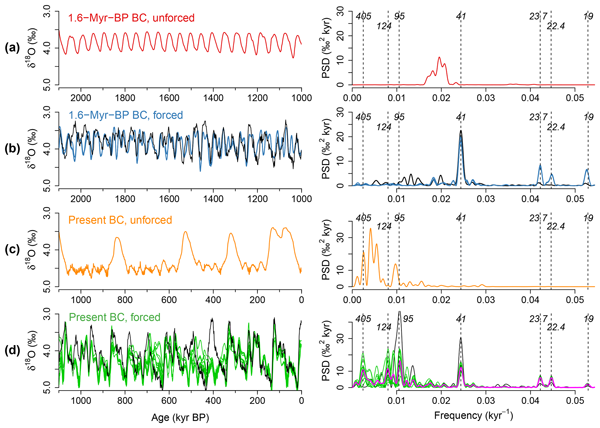
Synchronization phenomena observed in glacial–interglacial cycles simulated in an Earth system model of intermediate complexity
Abstract. The glacial–interglacial cycles of the Quaternary exhibit 41 kyr periodicity before the Mid-Pleistocene Transition (MPT) around 1.2–0.8 Myr ago and ∼ 100 kyr periodicity after that. From the viewpoint of dynamical systems, proposed mechanisms generating these periodicities are broadly...esd.copernicus.org
While we interpret the dominant periodicities of glacial cycles as the result of synchronization of internal self-sustained oscillations to the astronomical forcing, the Quaternary glacial cycles show facets of both synchronization and forced response.

Glad You Asked: Ice Ages – What are they and what causes them? - Utah Geological Survey
An ice age is a long interval of time (millions to tens of millions of years) when global temperatures are relatively cold and large areas of the Earth are covered by continental ice sheets and alpine glaciers. Within an ice age are multiple shorter-term periods of warmer temperatures when...geology.utah.gov
One significant trigger in initiating ice ages is the changing positions of Earth’s ever-moving continents, which affect ocean and atmospheric circulation patterns.
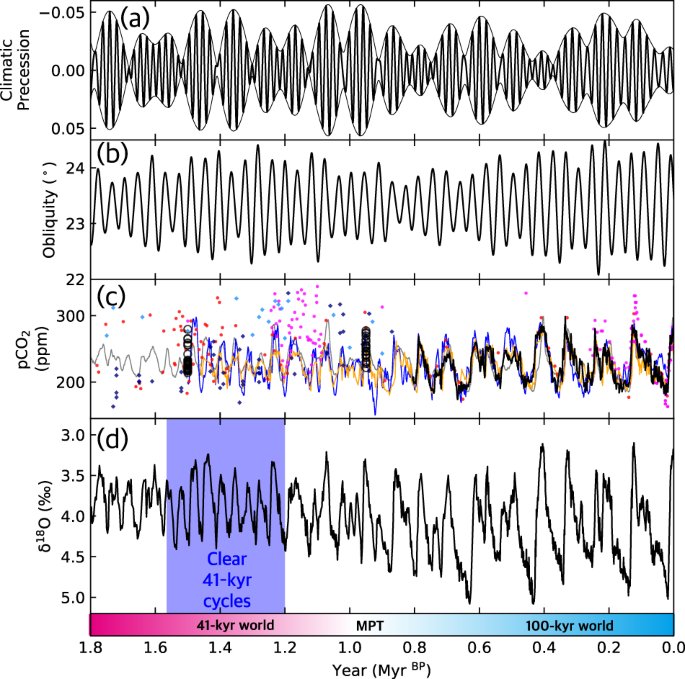
Astronomical forcing shaped the timing of early Pleistocene glacial cycles - Communications Earth & Environment
The timing of precession and obliquity cycles determined the duration of each glacial/interglacial period during the Early Pleistocene, according to dynamic ice-sheet-climate simulations of the glacial cycles between 1.6 and 1.2 million years ago.www.nature.com
The lead-lag relationship between precession and obliquity controls the length of interglacial periods, the shape of the glacial cycle, and the glacial ice-sheet geometry.
Glacial cycles are driven by cyclical changes in Earth's orbital parameters: obliquity, precession, and eccentricity.
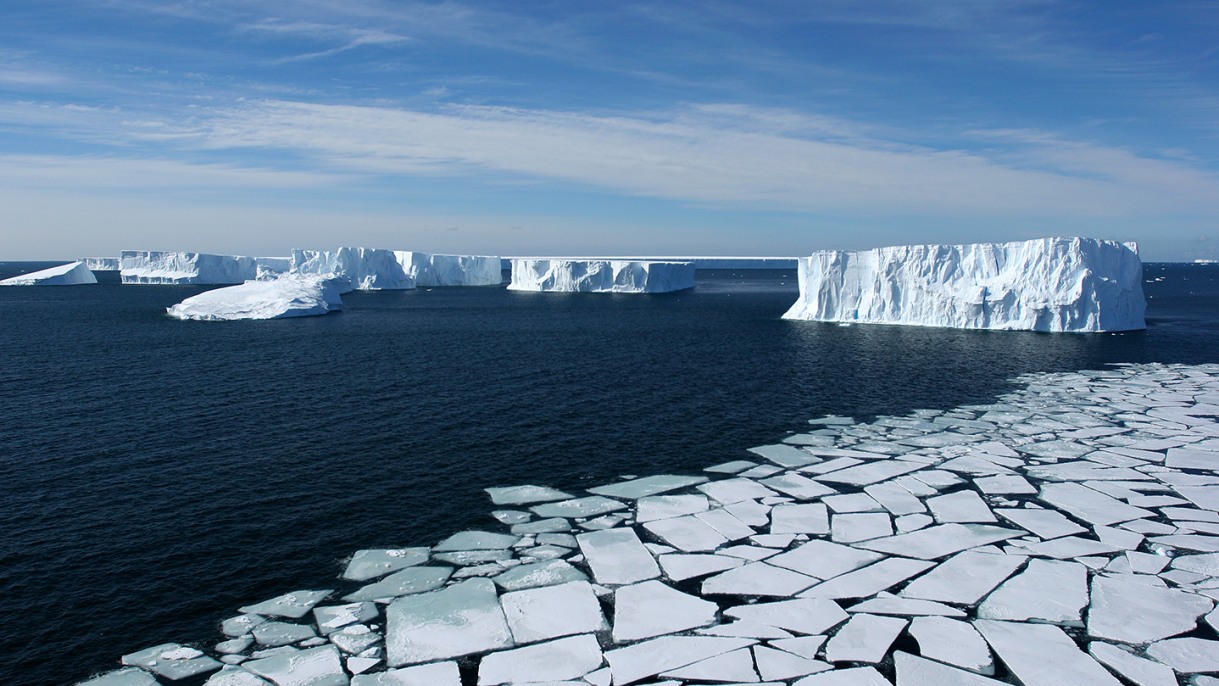
Earth’s orbital variations and sea ice synch glacial periods
Climate simulations show how changes in Earth’s orbit alter the distribution of sea ice on the planet, helping to set the pace for the glacial cycle.www.brown.edu
Each of these Milankovitch Cycles can influence the amount of sunlight the planet receives, which in turn can influence climate. The changes cycle through every 100,000, 41,000 and 21,000 years.
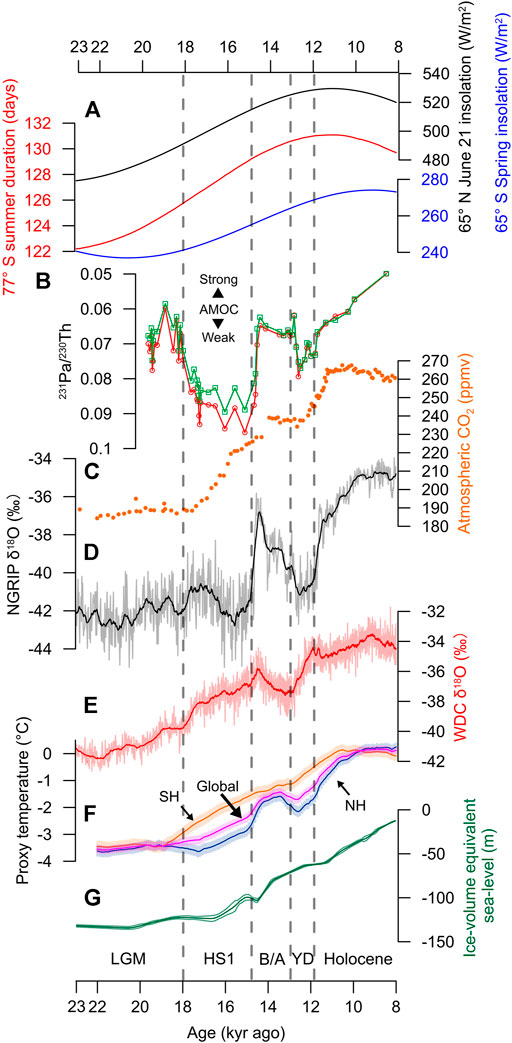
Frontiers | Earth Ice Age Dynamics: A Bimodal Forcing Hypothesis
The Earth has gone through multiple ice ages in the past million years. Understanding the ice age dynamics is crucial to paleoclimatic study, and is helpful ...www.frontiersin.org
The Earth has gone through multiple ice ages in the past million years. Understanding the ice age dynamics is crucial to paleoclimatic study, and is helpful for addressing future climate challenges. Though ice ages are paced by variations in Earth’s orbit geometry, how various climatic system components on the Earth respond to insolation forcing and interact with each other remains unclear.
A transition from low-amplitude sinusoidal obliquity (~41 ky) and precession (~23 ky) driven glacial/interglacial cycles to high-amplitude ~100 ky likely eccentricity-related sawtooth cycles seen between −1.25 My and −0.75 My BP (the Mid-Pleistocene transition or “MPT”) in FIT simulations disappears in BIT integrations depending on the details of how the regolith removal process is treated.
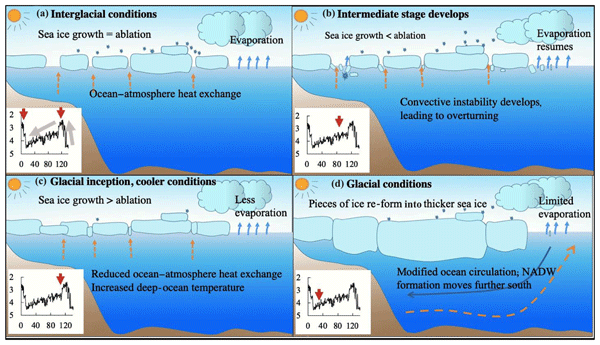
ESD Ideas: Why are glaciations slower than deglaciations?
Abstract. The Earth's climate during the Quaternary is dominated by short warm interglacials and longer cold glaciations paced by external forcings such as changes in insolation. Although not observed in the solar radiation changes, the time series of the cycles display asymmetry since...esd.copernicus.org
While it is mostly agreed that astronomical forcings trigger glacial–interglacial transitions, a similar shape is not observed in insolation changes, suggesting a nonlinear response by the climate system (Lisiecki and Raymo, 2007).
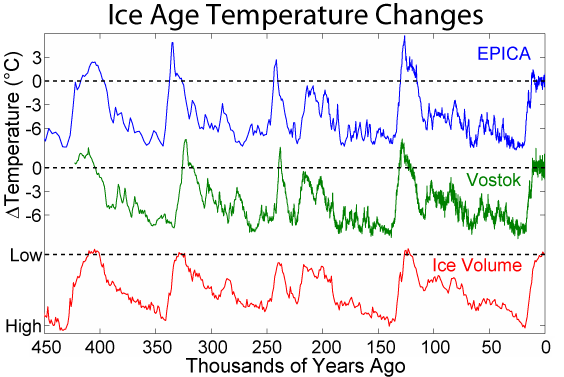
Interglacial - Wikipedia
en.wikipedia.org
Interglacials and glacials coincide with cyclic changes in Earth's orbit. Three orbital variations contribute to interglacials. The first is a change in Earth's orbit around the Sun, or eccentricity. The second is a shift in the tilt of Earth's axis, or obliquity. The third is the wobbling motion of Earth's axis, or precession.[Eldredge, S. "Ice Ages – What are they and what causes them?". Utah Geological Survey. Retrieved 2 March 2013.]
How do these orbital parameters change irradiation? ... specifically obliquity ... and show your math please ...
August West
Platinum Member
- Sep 5, 2014
- 15,335
- 6,795
- 400
No one likes Greedflation.View attachment 995122
In my next episode of the Cosmos, we will show how the democrat party that can't even control inflation will nowhttps://www.forbes.com/advisor/credit-cards/greedflation-statistics-2024/ magically control the weather if we only surrender enough our money and freedom to them.

‘Greedflation’ Statistics & Trends 2024
As inflation continues to rattle Americans, critics say corporations have worsened consumers’ pain by engaging in price gouging. The idea that big companies have exploited inflation pressures from the Covid-19 pandemic, the war in Ukraine and other events to generate excessive profits has been dubbe
ReinyDays
Gold Member
No one likes Greedflation.

‘Greedflation’ Statistics & Trends 2024
As inflation continues to rattle Americans, critics say corporations have worsened consumers’ pain by engaging in price gouging. The idea that big companies have exploited inflation pressures from the Covid-19 pandemic, the war in Ukraine and other events to generate excessive profits has been dubbewww.forbes.com
Yeah ... but who skips on profit? ...
Similar threads
- Replies
- 5
- Views
- 409
- Replies
- 9
- Views
- 338
- Replies
- 7
- Views
- 534
New Topics
-
-
250th Anniversary of the Army Grand Military Parade – 6:30pm ET Livestream Links
- Started by DonGlock26
- Replies: 2
-
"Tragic Assassination of Minnesota Democrat Lawmakers Shocks the Nation.
- Started by Ropey
- Replies: 14
-
Has to much U.S. support for Israel, embolden Israel to attack Iran?!??!
- Started by 52ndStreet
- Replies: 2
-
Latest Discussions
-
-
Leftist insurrectionists try to storm and take over the US Capital.
- Latest: Independent thinker
-
-